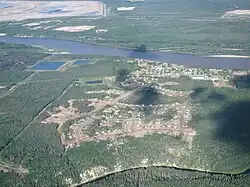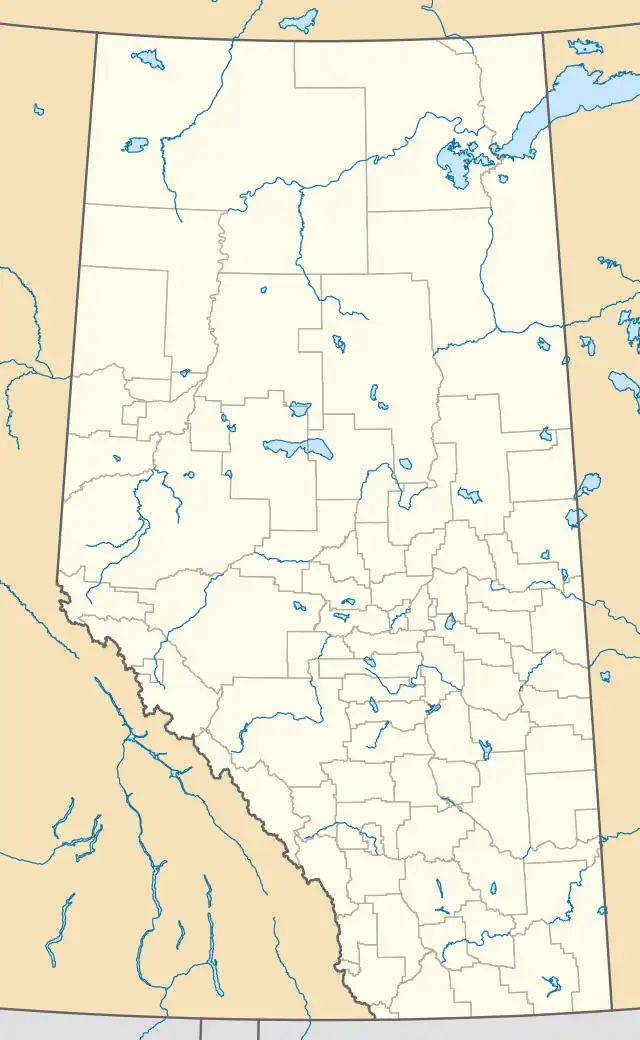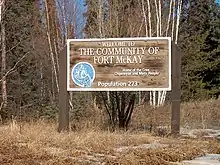Fort McKay
Fort McKay (/məˈkaɪ/ mə-KY)[3] or Fort MacKay is a community in northeast Alberta, Canada that is located at the confluence of the Athabasca and MacKay rivers. It is approximately 54 km (34 mi) north of Fort McMurray via Highway 63 and Fort McKay Road. The community has an elevation of 260 m (850 ft).
Fort McKay
Fort MacKay | |
|---|---|
 Aerial view of Fort McKay | |
 Fort McKay Location of Fort McKay in Alberta | |
| Coordinates: 57°10′52″N 111°35′59″W | |
| Country | Canada |
| Province | Alberta |
| Census division | No. 16 |
| Specialized municipality | RM of Wood Buffalo |
| Established | 1820[1] |
| Named | 1912[1] |
| Government | |
| • Mayor | Don Scott |
| • Governing body | Wood Buffalo Municipal Council
|
| Area | |
| • Total | 9.53 km2 (3.68 sq mi) |
| Elevation | 260 m (850 ft) |
| Population | |
| • Total | 742 |
| • Density | 77.9/km2 (202/sq mi) |
| Time zone | UTC-7 (MST) |
| • Summer (DST) | UTC-6 (MDT) |
| Postal code span | |
| Area code(s) | 780, 587, 825 |
| Highways | Highway 63 |
| Waterways | Athabasca River |
| Website | RM of Wood Buffalo |
The majority of the community is an Indian settlement of the Fort McKay First Nation (FMFN). The smaller portion of the community, known as Fort MacKay before 2018, is located adjacent to the FMFN lands to the south within the Regional Municipality (RM) of Wood Buffalo. The portion of the community within the RM of Wood Buffalo is designated as a hamlet.[4][5][6]
History

The community was named in 1912 after Dr. Williams Morrison MacKay, the first president of the Northern Alberta Medical Association.[5][6] The community's name is spelled Fort McKay by the Fort McKay First Nation.[6] In August 2012, the Fort McKay Métis Community requested the RM of Wood Buffalo to change the name of the hamlet to Fort McKay.[7][8][9] The change was recognized by the RM on January 22, 2018.[3]
- 2016 wildfire
Fort McKay hosted 5000 evacuees from the 2016 Fort McMurray Wildfire but itself was put under an evacuation notice due to the northward advance of the flames toward the community.[10][11]
Geography
- Climate
Fort McKay has a subarctic climate (Köppen climate classification Dfc).[12] and falls into the NRC Plant Hardiness Zone 3a.[13] Summers are mild and short, and winters can be long and cold.
Demographics
- Settlement
In the 2016 Census of Population conducted by Statistics Canada, the Fort McKay settlement recorded a population of 742 living in 250 of its 303 total private dwellings, a 32% change from its 2011 population of 562. With a land area of 9.53 km2 (3.68 sq mi), it had a population density of 77.9/km2 (201.7/sq mi) in 2016.[2]
In the 2011 Census, the Fort McKay settlement had a population of 562 living in 201 of its 235 total dwellings, a 7.9% change from its 2006 population of 521. With a land area of 8.17 km2 (3.15 sq mi), it had a population density of 68.79/km2 (178.16/sq mi) in 2011.[14]
- Hamlet
The population of the hamlet portion of Fort McKay according to the 2018 municipal census conducted by the Regional Municipality of Wood Buffalo is 59,[18] an increase from its 2015 municipal census population count of 51.[19]
Economy
The economy is centred on the development of the Athabasca oil sands to the immediate south and north. Motorists travelling north on Highway 63 pass through oil sands developments en route to the community.
Government
The community is located in the federal riding of Fort McMurray—Cold Lake.
Infrastructure
The community is located 6 km (3.7 mi) north of Highway 63 via Fort McKay Road, and is served by air at the Fort MacKay/Horizon Airport.
References
- "1820 to Present Discovery and Growth". Fort McKay - About us. Fort McKay First Nation. Retrieved May 7, 2016.
- "Population and dwelling counts, for Canada, provinces and territories, and census subdivisions (municipalities), 2016 and 2011 censuses – 100% data (Alberta)". Statistics Canada. February 8, 2017. Retrieved February 8, 2017.
- Condon, Olivia (January 23, 2018). "F'Spirit of reconciliation' at council's Fort McKay meeting". Postmedia Network. Fort McMurray Today. Retrieved February 7, 2018.
- "Specialized and Rural Municipalities and Their Communities" (PDF). Alberta Municipal Affairs. January 12, 2022. Retrieved January 21, 2022.
- "Fort MacKay". Regional Municipality of Wood Buffalo. Archived from the original on December 24, 2013. Retrieved May 13, 2011.
- "About Fort McKay". Fort McKay First Nation. Retrieved May 13, 2011.
- "Council Meeting Request" (PDF). Regional Municipality of Wood Buffalo. August 28, 2011. Retrieved May 8, 2016.
- "Approved Minutes of a Meeting of the Council of the Regional Municipality of Wood Buffalo". Regional Municipality of Wood Buffalo. August 28, 2012. Retrieved May 8, 2016.
- McDermott, Vincent (August 28, 2012). "Fort MacKay requests name change". Postmedia Network. Fort McMurray Today. Retrieved May 8, 2016.
- Bird, Cullen (May 7, 2016). "Fort McKay under voluntary evacuation order as wildfire size expected to double". Postmedia Network. Fort McMurray Today. Archived from the original on May 8, 2016. Retrieved May 7, 2016.
- "Fort McKay First Nation welcomed 5,000 people at wildfire evacuation's peak". Aboriginal Peoples Television Network. Aboriginal Peoples Television Network. Archived from the original on June 2, 2016. Retrieved May 7, 2016.
- "Climate Regions". Archives - Environment Canada. Environment Canada. Archived from the original on September 9, 2015. Retrieved May 7, 2016.
- "Plant Hardiness Zone by Municipality". Natural Resources Canada. Government of Canada. Retrieved May 7, 2016.
- "Census Profile – Fort Mackay, S-E, Alberta (Census subdivision)". Statistics Canada. May 2, 2015. Retrieved May 8, 2016.
- "Electronic Area Profiles: Profile of Census Divisions and Subdivisions, 1996 Census – Fort Mackay, S-E". Statistics Canada. December 23, 2013. Retrieved May 8, 2016.
- "Community Highlights for Fort Mackay". Statistics Canada. August 26, 2013. Retrieved May 8, 2016.
- "2006 Community Profiles – Fort Mackay, Alberta (Indian settlement)". Statistics Canada. January 5, 2015. Retrieved May 8, 2016.
- "census2018 Municipal Census Report" (PDF). Regional Municipality of Wood Buffalo. Archived from the original (PDF) on September 10, 2020. Retrieved September 25, 2021.
- "Province Approves 2015 Municipal Census Figures". Regional Municipality of Wood Buffalo. February 23, 2016. Archived from the original on May 5, 2016. Retrieved May 8, 2016.